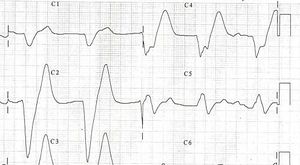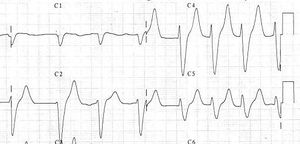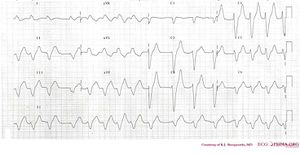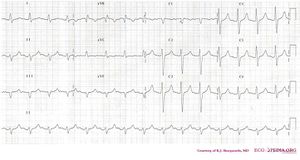Electrolyte Disorders: Difference between revisions
Jump to navigation
Jump to search
m (Reverted edits by 195.229.242.57 (Talk); changed back to last version by Drj) |
No edit summary |
||
| Line 4: | Line 4: | ||
|supervisor= | |supervisor= | ||
}} | }} | ||
==Hypercalcemia== | |||
Hypercalcemia results in a faster repolarization. Characteristics of hypercalcemia: | Hypercalcemia results in a faster repolarization. Characteristics of hypercalcemia: | ||
*mild: broad based tall peaking T waves | *mild: broad based tall peaking T waves | ||
*severe: extremely wide QRS, low R wave, disappearance of p waves, tall peaking T waves. | *severe: extremely wide QRS, low R wave, disappearance of p waves, tall peaking T waves. | ||
==Hypocalcemia== | |||
ECG-characteristics of hypocalcemia: | ECG-characteristics of hypocalcemia: | ||
*narrowing of the QRS complex | *narrowing of the QRS complex | ||
| Line 18: | Line 18: | ||
*prolonged ST and ST-depression | *prolonged ST and ST-depression | ||
==Hyperkalemia== | |||
[[Image:ecg_hyperkaliemie.jpg|thumb| Extreme hyperkalemia. No p-waves, wide QRS, tall peaking T waves.]] | [[Image:ecg_hyperkaliemie.jpg|thumb| Extreme hyperkalemia. No p-waves, wide QRS, tall peaking T waves.]] | ||
[[Image:ecg_hyperkaliemie2.jpg|thumb| Same patient after partial correction of the potassium level. Still no p-waves visible, wide QRS, tall peaking T waves.]] | [[Image:ecg_hyperkaliemie2.jpg|thumb| Same patient after partial correction of the potassium level. Still no p-waves visible, wide QRS, tall peaking T waves.]] | ||
| Line 29: | Line 29: | ||
{{clr}} | {{clr}} | ||
==Hypokalemia== | |||
[[Image:KJcasu18-3.jpg|thumb| Consecutive ECGs of a patient with hypokalemia. ECG1]] | [[Image:KJcasu18-3.jpg|thumb| Consecutive ECGs of a patient with hypokalemia. ECG1]] | ||
[[Image:KJcasu18-2.jpg|thumb| Consecutive ECGs of a patient with hypokalemia. ECG2]] | [[Image:KJcasu18-2.jpg|thumb| Consecutive ECGs of a patient with hypokalemia. ECG2]] | ||
Revision as of 13:09, 28 April 2008
| Author(s) | J.S.S.G. de Jong | |
| Moderator | T.T. Keller | |
| Supervisor | ||
| some notes about authorship | ||
Hypercalcemia
Hypercalcemia results in a faster repolarization. Characteristics of hypercalcemia:
- mild: broad based tall peaking T waves
- severe: extremely wide QRS, low R wave, disappearance of p waves, tall peaking T waves.
Hypocalcemia
ECG-characteristics of hypocalcemia:
- narrowing of the QRS complex
- reduced PR interval
- T wave flattening and inversion
- prolongation of the QT-interval
- prominent U-wave
- prolonged ST and ST-depression
Hyperkalemia
ECG characteristics of hyperkalemia:
- Tall peaked T waves
- Flattening p-waves. In extreme hyperkalemia p-waves may disappear altogether.
- Prolonged depolarization leading to QRS widening (nonspecific intraventricular conduction defect) sometimes > 0.20 seconds
At concentrations > 7.5 mmol/L atrial and ventricular fibrillation can occur.
Hypokalemia
Hypokalemia is a low blood potassium level. This results in:
- ST depression and flattening of the T wave
- Negative T waves
- A U-wave may be visible




